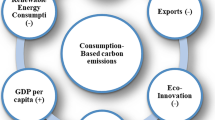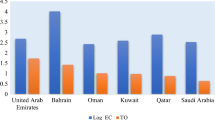Abstract
Countries try to stabilize the demand for energy on one hand and sustain economic growth on the other, but the worsening global warming and climate change problems have put pressure on them. This paper estimates the environmental Kuznets curve over the period 1971–2010 in Turkey both in the short and the long run. For this purpose, the unit root test with structural breaks and the cointegration analysis with multiple endogenous structural breaks are used. The effects of energy consumption and export product diversification on CO2 emissions are also controlled in the dynamic empirical models. It is observed that the environmental Kuznets curve hypothesis is valid in Turkey in both the short run and the long run. The positive effect on energy consumption on CO2 emissions is also obtained in the long run. In addition, it is found that a greater product diversification of exports yields higher CO2 emissions in the long run. Inferences and policy implications are also discussed.
Similar content being viewed by others
Notes
In other words, finding the diversification of exports to positively contribute to CO2 emissions implies that the relationship between two variables is negative. The positive sign implies that the concentration of exports positively contributes to CO2 emissions. We refer to Papageorgiou and Spatafora (2012) for the technical details and calculation method of the export product diversification (Theil) index.
References
Aditya A, Acharyya R (2013) Export diversification, composition, and economic growth: evidence from cross-country analysis. J Int Trade Econ Dev 22(7):959–992
Ageliki A, Ioannis P (2016) Eurasian orientation and global trade integration: the case of Turkey. Eurasian Economic Review 6(2):275–287
Agosin MR, Alvarez R, Bravo-Ortega C (2012) Determinants of export diversification around the world: 1962–2000. World Economy 35(3):295–315
Akbostanci E, Turut-Asik S, Tunc GI (2009) The relationship between income and environment in Turkey: is there an environmental Kuznets curve? Energy Policy 37(3):861–867
Al-Marhubi F (2000) Export diversification and growth: an empirical investigation. Appl Econ Lett 7(9):559–562
Ang JB (2008) Economic development, pollutant emissions and energy consumption in Malaysia. J Policy Model 30(2):271–278
Ang JB (2009) CO2 emissions, research, and technology transfer in China. Ecol Econ 68(10):2658–2665
Apergis N, Lau MCK (2015) Structural breaks and electricity prices: further evidence on the role of climate policy uncertainties in the Australian electricity market. Energy Econ 52:176–182
Apergis N, Payne JE (2009) Energy consumption and economic growth in central America: evidence from a panel cointegration and error correction model. Energy Econ 31(3):211–216
Bento JPC, Moutinho V (2016) CO2 emissions, non-renewable and renewable electricity production, economic growth and international trade in Italy. Renew Sust Energ Rev 55:142–155
Bilgili F, Koçak E, Bulut U (2016) The dynamic impact of renewable energy consumption on CO2 emissions: a revisited environmental Kuznets curve approach. Renew Sust Energ Rev 54:838–845
Bölük G, Mert M (2015) The renewable energy, growth and environmental Kuznets curve in Turkey: an ARDL approach. Renew Sust Energ Rev 52:587–595
Cadot O, Celine C, Strauss-Kahn V (2011) Export diversification: what’s behind the hump? Rev Econ Stat 93(2):590–605
Can M, Gozgor G (2016) Dynamic relationships among CO2 emissions, energy consumption, economic growth, and economic complexity in France. Munich Personal RePEc Archive; No: 70373
De Pineres SAG, Ferrantino M (1997) Export diversification and structural dynamics in the growth process: the case of Chile. J Dev Econ 52(2):375–391
De Vita G, Katircioglu S, Altinay L, Fethi S, Mercan M (2015) Revisiting the environmental Kuznets curve hypothesis in a tourism development context. Environ Sci Pollut Res 22(21):16652–16663
Dinda S, Coondoo D (2006) Income and emissions: a panel data-based cointegration analysis. Ecol Econ 57(2):167–181
Dogan E, Turkekul B (2016) CO2 emissions, real output, energy consumption, trade, urbanization and financial development: testing the EKC hypothesis for the USA. Environ Sci Pollut Res 23(2):1203–1213
Farhani S, Ozturk I (2015) Causal relationship between CO2 emissions, real GDP, energy consumption, financial development, trade openness, and urbanization in Tunisia. Environ Sci Pollut Res 22(20):15663–15676
Fodha M, Zaghdoud O (2010) Economic growth and pollutant emissions in Tunisia: an empirical analysis of the environmental Kuznets curve. Energy Policy 38(2):1150–1156
Friedl B, Getzner M (2003) Determinants of CO2 emissions in a small open economy. Ecol Econ 45(1):133–148
Gozgor G, Can M (2016a) Does export product quality matter for CO2 emissions? Evidence from China. Munich Personal RePEc Archive; No: 71873
Gozgor G, Can M (2016b) Effects of the product diversification of exports on income at different stages of economic development. Eurasian Business Review 6(2):215–235
Grossman GM, Krueger AB (1995) Economic growth and the environment. Q J Econ 110(2):353–377
Halicioglu F (2009) An econometric study of CO2 emissions, energy consumption, income and foreign trade in Turkey. Energy Policy 37(3):1156–1164
Heil MT, Selden TM (1999) Panel stationarity with structural breaks: carbon emissions and GDP. Appl Econ Lett 6(4):223–225
Herzer D, Nowak-Lehmann FD (2006) What does export diversification do for growth? An econometric analysis. Appl Econ 38(15):1825–1838
Hesse H (2008) Export diversification and economic growth. International Bank for Reconstruction and Development / the World Bank Commission on Growth and Development Working Paper, No. 21, Washington, D.C.: World Bank
Imbs J, Wacziarg R (2003) Stages of diversification. Am Econ Rev 93(1):63–86
Itkonen JVA (2012) Problems estimating the carbon Kuznets curve. Energy 39(1):274–280
Javid M, Sharif F (2016) Environmental Kuznets curve and financial development in Pakistan. Renew Sust Energ Rev 54:406–414
Jayanthakumaran K, Verma R, Liu Y (2012) CO2 emissions, energy consumption, trade and income: a comparative analysis of China and India. Energy Policy 42:450–460
Jebli MB, Youssef SB, Ozturk I (2016) Testing environmental Kuznets curve hypothesis: the role of renewable and non-renewable energy consumption and trade in OECD countries. Ecol Indic 60:824–831
Kaika D, Zervas E (2013a) The environmental Kuznets curve (EKC) theory—part a: concept, causes and the CO2 emissions case. Energy Policy 62:1392–1402
Kaika D, Zervas E (2013b) The environmental Kuznets curve (EKC) theory. Part B: critical issues. Energy Policy 62:1403–1411
Kanjilal K, Ghosh S (2013) Environmental Kuznets’s curve for India: evidence from tests for cointegration with unknown structural breaks. Energy Policy 56:509–515
Katircioglu ST (2014) Testing the tourism-induced EKC hypothesis: the case of Singapore. Econ Model 41:383–391
Klinger B, Lederman D (2006) Diversification, innovation, and imitation inside the global technology frontier. World Bank Policy Research Working Paper, No. 3872, Washington, D.C.: World Bank
Lean HH, Smyth R (2010) CO2 emissions, electricity consumption and output in ASEAN. Appl Energy 87(6):1858–1864
Lee J, Strazicich MC (2003) Minimum Lagrange multiplier unit root test with two structural breaks. Rev Econ Stat 85(4):1082–1089
Lee J, Strazicich MC (2013) Minimum LM unit root test with one structural break. Econ Bull 33(4):2483–2492
Ling CH, Ahmed K, Binti Muhamad R, Shahbaz M (2015) Decomposing the trade-environment nexus for Malaysia: what do the technique, scale, composition, and comparative advantage effect indicate? Environ Sci Pollut Res 22(24):20131–20142
Maki D (2012) Tests for cointegration allowing for an unknown number of breaks. Econ Model 29(5):2011–2015
Managi S, Jena PR (2008) Environmental productivity and Kuznets curve in India. Ecol Econ 65(2):432–440
Narayan PK, Narayan S (2010) Carbon dioxide emission and economic growth: panel data evidence from developing countries. Energy Policy 38(1):661–666
Nasir M, Rehman FU (2011) Environmental Kuznets curve for carbon emissions in Pakistan: an empirical investigation. Energy Policy 39(3):1857–1864
Omri A (2014) An international literature survey on energy-economic growth nexus: evidence from country-specific studies. Renew Sust Energ Rev 38:951–959
Onafowora OA, Owoye O (2014) Bound testing approach to analysis of the environment Kuznets curve hypothesis. Energy Econ 44:47–62
Ozcan B (2013) The nexus between carbon emissions, energy consumption and economic growth in Middle East countries: a panel data analysis. Energy Policy 62:1138–1147
Ozturk IA (2010) Literature survey of energy growth nexus. Energy Policy 38(1):340–349
Ozturk I, Al-Mulali U, Saboori B (2016) Investigating the environmental Kuznets curve hypothesis: the role of tourism and ecological footprint. Environ Sci Pollut Res 23(2):1916–1928
Pao H–T, Tsai C-M (2010) CO2 emissions, energy consumption and economic growth in BRIC countries. Energy Policy 38(12):7850–7860
Papageorgiou C, Spatafora N (2012) Economic diversification in LICs: stylized facts and macroeconomic implication. IMF Staff Discussion Notes 12/13, Washington, D.C.: International Monetary Fund
Payne JE (2010) A survey of the electricity consumption-growth literature. Appl Energy 87(3):723–731
Romero-Avila D (2008) Questioning the empirical basis of the environmental Kuznets curve for CO2: new evidence from a panel stationary test robust to multiple breaks and cross-dependence. Ecol Econ 64(3):559–574
Saboori B, Sulaiman J (2013) CO2 emissions, energy consumption and economic growth in Association of Southeast Asian Nations (ASEAN) countries: a cointegration approach. Energy 55:813–822
Song T, Zheng T, Tong L (2008) An empirical test of the environmental Kuznets curve in China: a panel cointegration approach. China Econ Rev 19(3):381–392
Soytas U, Sari R (2009) Energy consumption, economic growth, and carbon emissions: challenges faced by an EU candidate member. Ecol Econ 68(6):1667–1675
Soytas U, Sari R, Ewing BT (2007) Energy consumption, income and carbon emissions in the United States. Ecol Econ 62(3–4):482–489
Stock J, Watson MWA (1993) Simple estimator of cointegrating vectors in higher order integrated systems. Econometrica 61(4):783–820
Strazicich MC, Lee J, Day E (2004) Are incomes converging among OECD countries? Time series evidence with two structural breaks. J Macroecon 26(1):131–145
Tang CF, Tan BW (2015) The impact of energy consumption, income and foreign direct investment on carbon dioxide emissions in Vietnam. Energy 79:447–454
Tunc GI, Turut-Asik S, Akbostanci E (2007) CO2 emissions vs. CO2 responsibility: an input-output approach for the Turkish economy. Energy Policy 35(2):855–868
Tutulmaz O (2015) Environmental Kuznets curve time series application for Turkey: why controversial results exist for similar models? Renew Sust Energ Rev 50:73–81
Wang Y, Zhang X, Kubota J, Zhu X, Lu GA (2015) Semi-parametric panel data analysis on the urbanization-carbon emissions nexus for OECD countries. Renew Sust Energ Rev 48:704–709
Yang G, Sun T, Wang J, Li X (2015) Modeling the nexus between carbon dioxide emissions and economic growth. Energy Policy 86:104–117
Zhang X-P, Cheng X-M (2009) Energy consumption, carbon emission, and economic growth in China. Ecol Econ 68(3):2706–2712
Acknowledgments
We would like to express our gratitude to five anonymous reviewers and the editor (Philippe Garrigues) for their valuable comments and suggestions, which substantially improved the paper. All the remaining errors are our own.
Author information
Authors and Affiliations
Corresponding author
Additional information
Responsible editor: Philippe Garrigues
Appendix 1
Appendix 1
Rights and permissions
About this article
Cite this article
Gozgor, G., Can, M. Export product diversification and the environmental Kuznets curve: evidence from Turkey. Environ Sci Pollut Res 23, 21594–21603 (2016). https://doi.org/10.1007/s11356-016-7403-9
Received:
Accepted:
Published:
Issue Date:
DOI: https://doi.org/10.1007/s11356-016-7403-9
Keywords
- Environmental Kuznets curve
- Energy consumption
- Export product diversification
- Time series modeling
- Structural breaks




